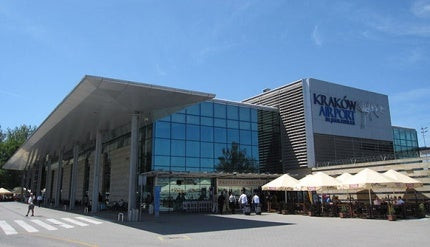John Paul II International Airport Kraków–Balice, often referred to as Krakow Airport, stands as Poland’s second busiest airport, serving as a crucial gateway to the historic city of Krakow and the southern Poland region. Located in Balice, a village approximately 11km west of Krakow city center, this airport efficiently connects millions of passengers to both domestic and international destinations each year. Originally opened for civil aviation in 1964, the airport received its present name in 1995 to honor Pope John Paul II, recognizing his deep connection to Poland and Krakow.
 Aerial view of John Paul II International Airport, Krakow, Poland, showcasing terminal buildings and apron.
Aerial view of John Paul II International Airport, Krakow, Poland, showcasing terminal buildings and apron.
Operated by LHC/KRK Airport Services, John Paul II International Airport Krakow handles a significant volume of air traffic. It manages over three million passengers annually, with aircraft movements exceeding 32,000. The airport features a single, concrete-paved runway, designated 07/25, measuring 2,550 meters in length, accommodating a wide range of aircraft.
Terminal Facilities at Krakow Airport
Krakow Airport is equipped with two primary passenger terminals along with a dedicated cargo terminal. Terminal 1 is designated for international flights, catering to the majority of travelers arriving from and departing to destinations outside Poland. Terminal 2, on the other hand, is dedicated to domestic flights, streamlining travel within Poland.
 Exterior view of Terminal buildings at Krakow Airport, highlighting modern architecture.
Exterior view of Terminal buildings at Krakow Airport, highlighting modern architecture.
Terminal 1 is structured across three levels to manage passenger flow efficiently. Level 0 is designed for international arrivals and departures, and houses essential services such as duty-free shops, car rental agencies, airline offices, and ATMs. Level 1 continues to serve international arrivals and departures and offers a range of shops, services, a chapel, and first aid facilities. For those interested in aviation views, Level 2 features an observation deck. Terminal 2, focusing on domestic travel, provides passenger amenities including ten check-in desks, four gates, two baggage claim belts, and essential services like a post office, bank, bureau de change, and restaurants. It also offers a VIP lounge, duty-free shops, tourist information, baby care facilities, accessibility features for disabled passengers, and a business center.
 Passengers walking through Terminal at John Paul II International Airport, Krakow.
Passengers walking through Terminal at John Paul II International Airport, Krakow.
The airport apron, located conveniently opposite the passenger terminals, provides a total surface area of 92,000m². This space can accommodate up to 17 medium-sized aircraft simultaneously, facilitating smooth ground operations.
Ongoing Terminal Expansion Project
Recognizing the increasing passenger traffic, John Paul II International Airport Krakow is currently undergoing a significant expansion and development of Terminal 1. This project, designed by APA Czech-Wróbel-Duliński Design Agency, encompasses the construction of a new 55,000m² terminal building that will be integrated with the existing international terminal. The expansion is being executed in three phases, commenced in 2013, and aimed for completion by 2015, to enhance the airport’s capacity and passenger experience.
The expansion project is financially supported by the Polish Airports State Enterprise, the majority stakeholder, and EU subsidies. The project aims to increase check-in counters to 46 and boarding gates to 18. Key features of the expansion include a new internal communication and transport system with five traffic lanes to improve terminal access. A footbridge will connect the expanded terminal to a multi-level car park, and a new four-star Hilton Garden Inn hotel is also part of the development, providing added convenience for travelers.
Air Traffic Control and Support Services
The air traffic control (ATC) tower at John Paul II International Airport Krakow manages air space within a 27km radius. It utilizes the British Marconi SRE and ASR radar system, incorporating both primary and secondary radars for precise air traffic management. The flight control tower is centrally located within the airport premises, approximately 500m south of the runway.
For maintenance and ground handling services, the airport hosts fixed base operators (FBO) including Excel Handling and LS Airport Services. Additionally, the airport provides extensive cargo facilities, featuring warehouses with 755m² of temperature-controlled storage, including heated, refrigerated, and deep-freeze storage options.
Ground Transportation to and from Krakow Airport
John Paul II International Airport Krakow offers diverse ground transportation options for passengers. The Balice Express train provides a direct rail link between Krakow city center and the Kraków-Balice Airport railway station. Bus services also connect the airport with both the railway station and the city center, offering economical travel options. Taxis and car rental services are readily available at the airport, providing convenient personalized transport solutions.
To accommodate drivers, the airport features a multi-level parking facility situated opposite the international passenger terminal. Constructed in 2010, this car park offers 863 parking spaces across five stories and 98,000m³, using substantial amounts of steel and concrete in its construction.
In conclusion, John Paul II International Airport Krakow is a vital infrastructure hub for Poland, offering modern facilities, ongoing expansions, and comprehensive services to millions of passengers annually. Its strategic location, coupled with continuous development, ensures its role as a key airport in Central Europe, facilitating travel to and from the culturally rich city of Krakow.
